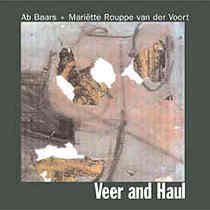|
Ab Baars - clarinet, tenor saxophone
Mariëtte Rouppe van der Voort- sopranino saxophone, alto saxophone, piccolo, alto flute, flute
|
|
|
all compositions Ab Baars | Mariëtte Rouppe van der Voort
BUMA | STEMRA
recorded by Dick Lucas DATA RECORDS
Bimhuis, 2 march 00 | Floratheater, Delft 3 march 00 | Bimhuis 25 januari 01 | Bethanienklooster 26 march 02
editing Dick Lucas | Ab Baars | Mariëtte Rouppe van der Voort
liner notes Erik van den Berg
cover art and photo Rob Glaser
design Francesca Patella
produced by Ig Henneman
thanks to: Fonds voor de Scheppende Toonkunst
|
|
Liner notes
Erik van den Berg
First impression: a clean slate. The improvised duets on this CD sound so startingly fresh, they seem to be rootless, without any history at all. Consider the beauty of 'Note One': a fluttering of the tenderest sounds on alto en tenor saxophone, that almost defies description. No melody, no chords, no fixed beat, nothing whatsoever -only a rapturous aural presence. Music that just dropped out of heaven.
But of course it didn't. Veer and Haul is the fruit of decades of hard work and dedication, with a history all its own. It began in a place called The Bunker. An ugly old spot on the Rotterdam harbor, which for a short while in the late 1970s housed a much loved jazz-laboratory. The Art Ensemble of Chicago left its footprints, Frank Wright and Julius Hemphill stopped by, and for months Butch Morris rounded up the local debutantes in workshops and sessions. A quarter century ago, this is were Ab Baars and Mariëtte Rouppe van der Voort found out they had more in common than a shared saxophone teacher.
Though Baars and Rouppe van der Voort also share a passion for jazz, they wouldn't call themselves jazz players per se. From their first groups onwards (the Bunker Sextet and its successor Cumulus) they have striven to unite improvising techniques with what they admire in contemporary chamber music. In her own Rouppe Group, the classically-trained flutist deftly mixes improvised pieces with short compositions by Charles Ives, György Kurtág and Henry Cowell. Baars, a lover of Ellington and Stravinsky, has studied with the Afro-American clarinet master John Carter. His eerie upper register piping implicitly honors his great mentor, but may also echo Olivier Messiaen's expeditions into ornithological territory.
Kurtág, Carter, Messiaen: just a few names to consider. Saxophonist Roscoe Mitchell's Duets with Anthony Braxton, recorded in 1977, also comes to mind. As do the introverted meanderings of Pee Wee Russell, Jimmy Giuffre's careful chalumeau-register intonations, or the wild flashes of Sun Ra altoist Marshall Allen. In short: as footloose as these fourteen cuts may seem, they are firmly planted in their own constellation of pioneers and predecessors.
For a collaboration that has been so fruitful (both players have shared the stage many times), it has remained strangely under-recorded. Apart from the early Carrousel (Data 841) and more recent Tentet recordings under the leadership of viola player Ig Henneman (Wig 03 and Wig 04), the duo's discography is notable for its brevity. The short-lived, but highly talented Cumulus never recorded - a fate that will hopefully escape the Rouppe Group, a quintet which has been touring since 1993. (Baars has some great CDs himself on the GeestGronden-label, Rouppe van der Voort's sopranino saxophone can be heard on a string of albums with the saxophone sextet The Six Winds).
This scarcity of recordings makes Veer and Haul all the more welcome. It is very much a successor to the 18-year old Carrousel (same obession with pitch deviations, for one thing), with all aspects raised to a superior level. Carrousel offered saxophone solos and duets, and a couple of trios with pianist Guus Janssen, as well as a considerable percentage of pre-meditated material. Veer and Haul is almost completely improvised. The sole exception pops up in the second half of track 13, in which Ab's clarinet recapitulates Luciano Berio's version of a Sicilian folk tune ('if we were fishes').
Among Carrousel's highlights were Rouppe van der Voort's 'Vijf korte vormen' (Five short forms). The fourth part seemed to be simplicity itself: clarinet and alto play nothing but a long, extended line in near unisono, focusing on the tiniest variations in pitch. In 1966 the Italian composer Giacinto Scelsi employed the same principle in his duet Ko-Lho for flute and clarinet, inviting players and listeners to make the most of seemingly insignificant material. On Veer and Haul's title track, clarinet and flute create a similar sparseness and intensity - with the priceless bonus of improvisation's immediacy and sense of risk.
Listen closely - and figure out if that can really be Ab's clarinet that opens 'E si fussi pisci', or who's responsible for that crazy klaxon in 'Part Two' (believe it or not, it's Mariëtte's sopranino). Extended techniques, alternate fingerings and multiphonics all contribute to an expanded tonal palette, precise and delicate even at its rawer edges.
Listen closely - and dig those dizzying, piercing notes in 'Vliegers' (Kites) or, in another universe, the serene finale of 'Bells', with its almost unbearably melancholy tattoo.
Can it really be 25 years?
Erik van den Berg
november 2002
|
|

